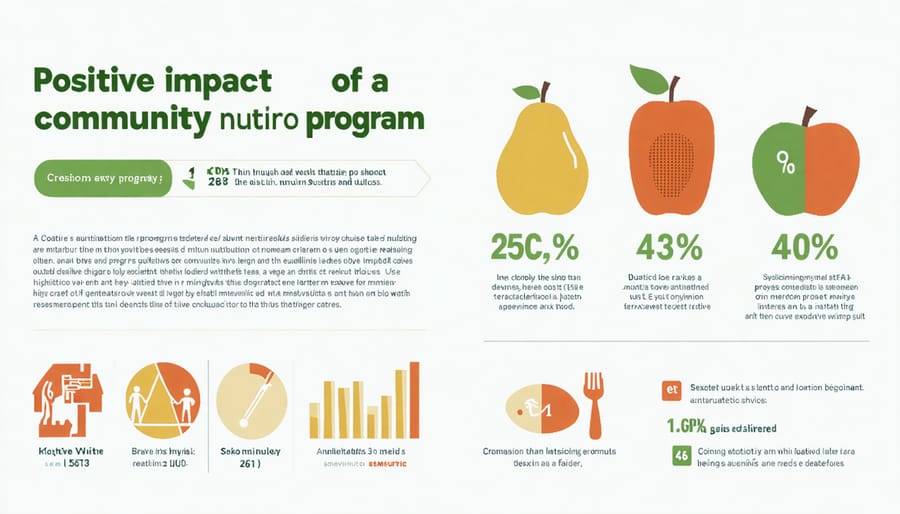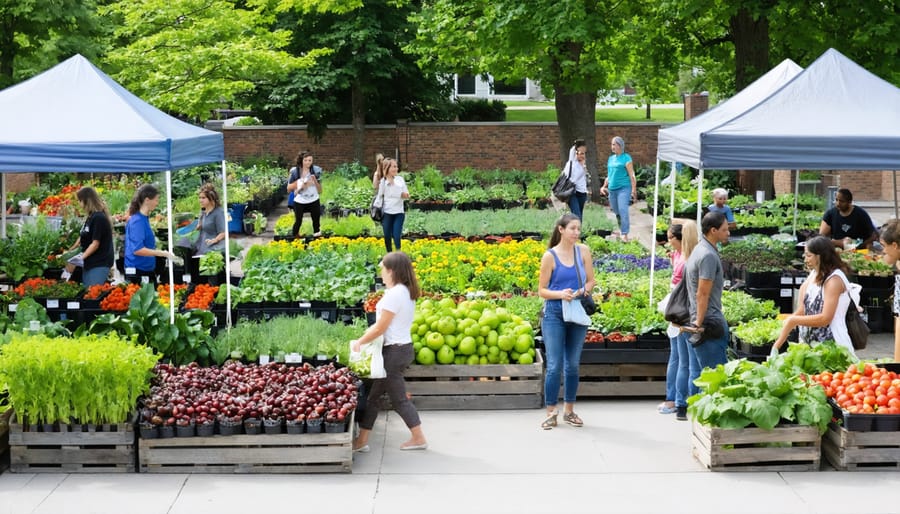The intersection of public health and community nutrition programs fundamentally shapes the health outcomes of Canadian neighborhoods. Food security, nutritional education, and accessible healthy eating resources form the cornerstone of thriving communities. Recent data shows that neighborhoods with robust nutrition initiatives experience up to 30% lower rates of diet-related chronic diseases and significantly improved mental health outcomes.
By addressing both individual dietary needs and systemic food access barriers, comprehensive nutrition programs create lasting positive change. From school meal programs serving over 2 million Canadian children daily to community gardens providing fresh produce in urban food deserts, these initiatives demonstrate the powerful impact of collective action on population health.
The success of these programs relies on three key elements: evidence-based intervention strategies, strong community partnerships, and sustainable implementation models. When local health authorities collaborate with community organizations, schools, and food security advocates, they create resilient systems that support long-term public health goals while meeting immediate nutritional needs.
This holistic approach to community nutrition not only improves physical health outcomes but also strengthens social connections, supports local food systems, and builds more resilient communities.
The Foundation of Community Nutrition Programs
Identifying Local Nutritional Needs
Assessing community nutritional needs begins with gathering key data through various methods, including food environment surveys, dietary intake assessments, and community health statistics. Local health units often conduct food security screenings and analyze demographics to identify vulnerable populations and specific dietary gaps.
Effective assessment strategies include conducting household surveys, analyzing shopping patterns at local grocery stores, and reviewing school meal program data. Healthcare providers can offer valuable insights through patient nutrition screenings, while community organizations often share observations about food access challenges and cultural dietary preferences.
To paint a complete picture of local needs, it’s important to consider factors such as:
– Access to fresh foods and grocery stores
– Income levels and food affordability
– Cultural food preferences
– Common health conditions in the community
– Available cooking facilities and food preparation knowledge
– Transportation options to food sources
These assessments help identify priority areas for intervention, such as the need for nutrition education programs, improved food access, or targeted support for specific populations. Regular monitoring and updates ensure that nutrition programs remain responsive to changing community needs.
Building Sustainable Food Systems
Building sustainable food systems requires a collaborative approach involving local governments, community organizations, and residents. By focusing on local food production, farmers’ markets, and community gardens, communities can create better access to fresh, nutritious foods. These initiatives not only improve food security but also support local economies and reduce environmental impact.
Key strategies include developing urban agriculture programs, establishing food policy councils, and partnering with community health resources to create comprehensive food access solutions. Mobile markets and food box programs can help reach underserved neighborhoods, while educational programs teach valuable skills in cooking, gardening, and food preservation.
Communities can also implement food recovery programs to redirect surplus food from restaurants and grocery stores to food banks and meal programs. Supporting local farmers through direct-to-consumer programs and institutional purchasing policies ensures a stable market for locally grown products while providing fresh, seasonal options for residents.
These approaches create resilient food systems that can better withstand supply chain disruptions while promoting health equity and environmental sustainability.

Effective Community Engagement Strategies
Cultural Competency in Nutrition Education
In Canada’s diverse cultural landscape, effective nutrition education requires a thoughtful approach that respects and incorporates various cultural perspectives. Successful public health initiatives recognize that food choices are deeply connected to cultural identity, traditions, and social practices.
Cultural competency in nutrition education involves understanding different cultural food practices, religious dietary restrictions, and traditional cooking methods. Programs must be adapted to include familiar ingredients and cooking techniques while maintaining alignment with Canada’s Food Guide recommendations.
Healthcare providers and nutrition educators should develop awareness of cultural dietary patterns and beliefs. This includes recognizing traditional healing practices, cultural celebrations involving food, and different approaches to meal planning and preparation across communities.
Practical strategies for culturally competent nutrition education include:
– Working with cultural community leaders to develop appropriate programming
– Using culturally relevant food examples and recipes
– Providing materials in multiple languages
– Incorporating traditional cooking demonstrations
– Respecting religious food practices and restrictions
Successful programs often employ educators from within the target communities who understand local customs and can communicate effectively with community members. This approach helps build trust and ensures that nutrition messages are delivered in culturally appropriate ways.
By embracing cultural diversity in nutrition education, programs can better serve Canada’s multicultural population while promoting healthy eating habits that respect and celebrate different cultural traditions.

Collaborative Partnership Development
Building effective partnerships is fundamental to successful public health and nutrition initiatives. By connecting with local organizations, healthcare providers, schools, and community groups, programs can reach more people and create lasting positive change. These community support systems form the backbone of sustainable nutrition programs.
Successful partnerships often begin by identifying shared goals and values among potential collaborators. Local food banks, farmers’ markets, and agricultural organizations can contribute to food security initiatives. Educational institutions can provide valuable research support and access to youth populations. Healthcare providers can offer expertise and direct connections to at-risk populations.
To develop strong partnerships:
– Start with clear communication about objectives and expectations
– Establish formal agreements that outline roles and responsibilities
– Share resources and expertise equitably
– Create regular opportunities for feedback and evaluation
– Celebrate shared successes and address challenges together
Consider forming a community advisory board that includes representatives from various stakeholder groups. This ensures diverse perspectives are heard and helps maintain program relevance. Regular meetings and open dialogue help identify emerging needs and opportunities for collaboration.
Remember that successful partnerships take time to develop and require ongoing nurturing. Building trust and maintaining transparent communication are essential for long-term success.
Success Stories: Canadian Communities Leading the Way
Across Canada, communities are making remarkable strides in improving public health through innovative nutrition programs. These successful wellness initiatives demonstrate how local action can create lasting positive change in population health.
In Québec City, the “Des jardins pour tous” (Gardens for All) program has transformed vacant lots into community gardens, providing fresh produce to over 2,000 families annually. The initiative includes nutrition education workshops and cooking classes, helping residents make the most of their harvest while building stronger community connections.
Vancouver’s “Farm to School BC” program has revolutionized school nutrition by connecting local farmers with school cafeterias. The program now serves over 30,000 students across British Columbia, increasing fresh food consumption while supporting local agriculture. Students participate in gardening activities and learn about sustainable food systems, creating healthy habits that last a lifetime.
In Nova Scotia, the “Mobile Food Market” brings affordable fresh produce to underserved communities using converted transit buses. This innovative approach has increased fruit and vegetable consumption by 40% in participating neighborhoods while creating new opportunities for local farmers.
The Indigenous Food Sovereignty initiative in Manitoba has successfully revitalized traditional food systems in First Nations communities. By combining elder knowledge with modern farming techniques, the program has improved food security while preserving cultural heritage.
Toronto’s “FoodShare” program demonstrates the power of community-driven solutions, serving over 250,000 people annually through various nutrition programs. Their Good Food Box program delivers affordable fresh produce to neighborhoods across the city, while their school nutrition programs ensure children have access to healthy meals.
These success stories share common elements: strong community engagement, sustainable funding models, and partnerships between multiple stakeholders. They prove that when communities work together, meaningful improvements in public health and nutrition are achievable and sustainable.

Measuring Impact and Ensuring Program Success
Measuring the success of community nutrition programs requires a systematic approach combining both quantitative and qualitative methods. Program evaluators typically track key health indicators such as changes in body mass index (BMI), blood pressure, and dietary habits through regular participant assessments. These measurements provide concrete data to demonstrate program effectiveness.
Surveys and questionnaires help gather feedback about participants’ knowledge, attitudes, and behaviors related to nutrition. Pre- and post-program assessments can reveal improvements in understanding of healthy eating principles and food preparation skills. Food diaries and meal tracking apps offer insights into actual dietary changes.
Community engagement metrics are equally important, including attendance rates, program completion rates, and participant satisfaction scores. Social impact can be measured through community health indicators, such as increased access to fresh foods or the number of families participating in community gardens.
Success indicators should also consider long-term sustainability. This includes tracking program costs, resource utilization, and volunteer retention rates. Regular monitoring helps identify areas for improvement and ensures programs remain cost-effective while meeting community needs.
To ensure continuous improvement, programs should establish:
– Clear, measurable objectives
– Regular data collection schedules
– Feedback mechanisms for participants
– Methods for tracking program modifications
– Documentation of successful strategies
Program evaluators should share results with stakeholders, including community members, healthcare providers, and funding organizations. This transparency helps build trust and support for ongoing nutrition initiatives while demonstrating their value to community health.
Public health and community nutrition play vital roles in building healthier, more resilient communities across Canada. Through coordinated efforts between healthcare professionals, community organizations, and engaged citizens, we can create lasting positive changes in our neighborhoods’ nutritional health. The evidence clearly shows that when communities work together to improve access to healthy foods and nutrition education, the benefits extend far beyond individual health outcomes.
To make a meaningful difference, we encourage you to get involved in your local community’s nutrition initiatives. Consider volunteering at food banks, supporting community gardens, or participating in nutrition education programs. Even small actions, like sharing healthy recipes with neighbors or advocating for better food policies in your area, can contribute to positive change.
Remember that building a healthier community is a collective journey. By combining our knowledge, resources, and dedication, we can create environments where nutritious food choices are accessible, affordable, and appealing to everyone. Your participation matters – join the movement today to help shape a healthier tomorrow for all Canadians.

